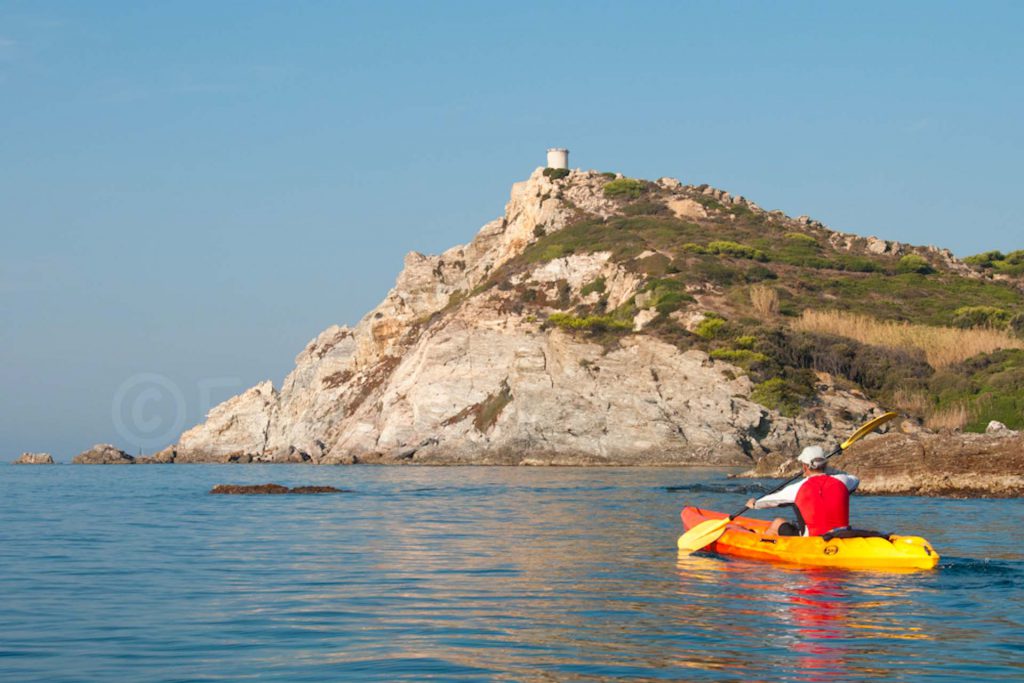Discovery of the Brusc lagoon by kayak
Starting from the beach at Salins under a blazing sun, the kayak boats move away after a lot of splashing and loose paddle strokes and glide along the port of Saint Pierre des Embiez with its forest of ship masts. The kayakers can feel the freedom and lightness of it all, gradually finding their bearings and enjoying the sensation of floating on such a stunning stretch of water.
The boats glide on the surface of the translucent water, which already allow a glimpse of a few bunches of Posidonia meadows. We carefully scan the sea bottom in an attempt to locate some rare giant mussels (Pinna nobilis), a species endemic to the Mediterranean which nearly became extinct but is gradually returning thanks to its protected status. The lagoon is very shallow, which makes observation easier. We will have the opportunity to detect the presence of various species of emblematic fish such as sea breams, basses, wrasses and combers. As early as spring, when the waters get warmer, the Brusc lagoon turns into a real nursery protected by a rocky barrier.
Along the diversified coast of the Embiez
While gliding along the coast of Embiez, kayakers can admire at leisure the various coves and beaches and paddle to the rhythm of the chant of cicadas giving in their all. The landscapes of this half-tamed, half-wild island are gently rolling and the Mediterranean vegetation reveals all its varied and scented splendour with palm trees, bay leaves, maritime pines and tamarinds. The island has some 35 acres of pine forests and 25 acres of vineyards.
After passing the island of Tour Fondue, the landscape changes dramatically and the vegetation gives way to limestone cliffs plunging into the turquoise-blue water. It is not uncommon to spot some peregrine falcons majestically perched on their observation post or cormorants spreading their wings to dry on rocky outcrops.
Sailing around the Embiez Archipelago
Kayaking is the ideal way to discover the islands and islets of the Embiez Archipelago. It is indeed the only water activity allowed in the entire 1,200-acre marine area including the periphery of Embiez Island. Traffic and navigation are prohibited through the entire stretch of water, both by powered craft or beach equipment except for kayak boats. Kayakers can thus enjoy a tranquil time on the stretch of water.
While paddling around Embiez Island, kayakers often realise that it is actually made of two islands. After gliding along the island of Saint Pierre des Embiez in the north, they can see the island of Tour Fondue in the south. The two islands are connected together by partial filling of former salt works. The South Island is indeed separated from the island of Grand Gaou, on its west side, by a pass called the Grand Pas du Coq. The rowers can this approach several islands or islets such as Petit Gaou, which is connected to the coast by a road, and Grand Gaou, which can be accessed from the mainland through a small wooden bridge.
For their part, the islands of Petit Rouveau and Grand Rouveau are situated further out at sea. The natural beauty of the island of Rouveau, which is the property of the French coastal protection organisation, has remained unspoilt. Emerging from the waves and set against a clear blue sky, its lighthouse is an ancestral symbol, having guided a large number of seamen through the reefs on the way to the Greek Phocean city of Massalia, a route used since very ancient times. The lighthouse is now automated and is powered by a wind turbine. While paddling in the surroundings, one cannot help but think of the number of shipwrecks that took place there, as has been confirmed by the shipwrecks discovered, especially the ‘épave des médailles’ (medal shipwreck) dating from the 15th century.



